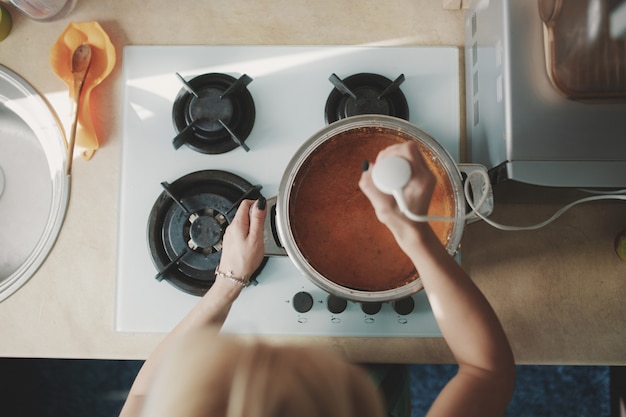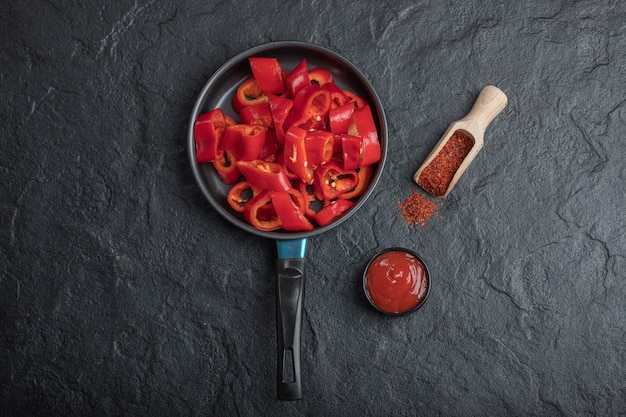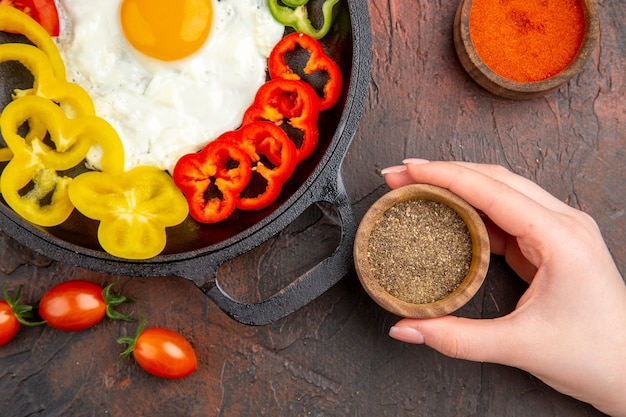You've got the urge for a comforting, warming chili, but you're unsure how long to simmer it in your slow cooker. I've been there, my friend. As a dedicated chili enthusiast, I've spent countless hours (and maybe a few too many bowls) experimenting with different cooking times to find that perfect blend of flavour and texture.
The truth is, there's no magic number for chili cooking time. It's a dance between the type of chili you're making, the ingredients you choose, and your personal taste preferences.
But fear not, I'm here to guide you through the maze. We'll break down everything you need to know about chili cooking times, from the fundamental principles to handy tips and tricks. So, grab your apron, gather your ingredients, and let's dive into the world of crock pot chili!
(Part 1) The Basics of Crock Pot Chili Cooking Times

Crock pots are the heroes of chili-making, offering a set-it-and-forget-it convenience. Their slow, gentle heat ensures that the meat gets tender and the flavours mingle beautifully. However, different recipes demand different cooking times, so understanding the fundamental principles is key.
Factors Affecting Chili Cooking Time
Several factors contribute to the chili's cooking time, influencing how long you'll need to simmer it. Let's explore these key players:
- Type of Meat: Beef, pork, and chicken all have their own unique cooking times. Beef typically requires a longer simmer, while chicken cooks faster.
- Cut of Meat: A tougher cut of meat, like chuck roast or shoulder, needs more time to become tender than a leaner cut like sirloin. Think of it as a workout for the meat, requiring more time to achieve that melt-in-your-mouth tenderness.
- Amount of Liquid: More liquid means a longer cooking time. It's a balancing act; the liquid allows the flavours to meld, but too much can lead to a watery chili.
- Type of Crock Pot: Different crock pots have different heating capabilities. A larger crock pot might take a bit longer to reach the desired temperature, while a smaller one could heat up more quickly.
- Desired Consistency: If you're craving a thick, hearty chili, you'll need to let it simmer longer to allow the liquid to evaporate. The longer cooking time will help to thicken the chili naturally.
General Guidelines
While every chili is unique, these general guidelines are a great starting point:
- Beef Chili: 6-8 hours on low, 3-4 hours on high. This gives the beef ample time to become tender and develop rich, deep flavours.
- Pork Chili: 4-6 hours on low, 2-3 hours on high. Pork tends to cook more quickly than beef, so a shorter simmer is usually sufficient.
- Chicken Chili: 3-4 hours on low, 1-2 hours on high. Chicken cooks quickly, so a shorter simmer is ideal to prevent it from becoming dry.
Adjusting for Different Ingredients
Remember, these guidelines are just a starting point. You'll need to adjust the cooking time based on your unique ingredients. For example, if you're using beans, adding them in the last hour or two of cooking prevents them from becoming mushy. And if you're using fresh vegetables, you'll want to add them closer to the end to preserve their texture and vibrant colours.
(Part 2) My Favourite chili recipe: A Taste of Home

Now, let's get our hands dirty! I've got a recipe that's been a family favourite for years. It's a hearty beef chili, bursting with flavour, perfect for a chilly evening.
Ingredients:
- 1.5 kg beef chuck roast, cut into 2.5 cm cubes – This tough cut of meat will become unbelievably tender after a long simmer.
- 1 tbsp olive oil – Just a touch to help brown the beef and add depth of flavour.
- 1 large onion, chopped – The sweetness of the onion balances the richness of the beef.
- 2 cloves garlic, minced – Garlic adds a pungent aroma and flavour that takes this chili to another level.
- 1 tbsp chili powder – The foundation of flavour, creating that signature chili taste.
- 1 tsp cumin – This spice adds a warm, earthy note that complements the beef beautifully.
- 1 tsp paprika – Adding a touch of sweetness and a subtle smokiness to the chili.
- 1/2 tsp cayenne pepper (or more to taste) – For a touch of heat, but feel free to adjust it based on your spice preference.
- 1 tsp salt – Essential for seasoning, but adjust to your taste.
- 1 tsp black pepper – Adding depth and complexity to the flavour profile.
- 1 (400g) can diced tomatoes, undrained – Tomato juice adds moisture and acidity, enhancing the overall flavour.
- 1 (400g) can kidney beans, drained and rinsed – Kidneys beans add texture and a hearty protein boost.
- 1 (400g) can pinto beans, drained and rinsed – Pinto beans add another dimension of texture and a creamy flavour.
- 1 cup beef broth – Adds moisture and a deeper beefy flavour.
- Optional: 1/2 cup chopped fresh cilantro for garnish – For a fresh, bright flavour to top off the chili.
Instructions:
- In a large skillet, heat the olive oil over medium heat.
- Add the beef and cook, stirring occasionally, until browned on all sides. This step is crucial for developing a richer flavour.
- Remove the beef from the skillet and set aside. Don't throw away the delicious juices in the skillet!
- Add the onion and garlic to the skillet and cook until softened, about 5 minutes. We want the onions to become translucent and sweet.
- Stir in the chili powder, cumin, paprika, cayenne pepper, salt, and black pepper. Cook for 1 minute, stirring constantly. This toasts the spices, releasing their full flavour potential.
- Add the beef, diced tomatoes, kidney beans, pinto beans, and beef broth to a slow cooker. Pour in those delicious juices from the skillet too!
- Cook on low for 6-8 hours, or on high for 3-4 hours, until the beef is tender. The slow cooker does the heavy lifting, allowing the flavours to meld and the meat to soften.
- Before serving, use a slotted spoon to remove some of the chili and blend it in a food processor or blender until smooth. This creates a richer, silkier texture and a deeper, more complex flavour.
- Stir the blended chili back into the pot and serve garnished with fresh cilantro, if desired. This adds a fresh, herbaceous touch and balances the richness of the chili.
Tips and Tricks:
- If you're feeling adventurous, you can add other ingredients to your chili, such as corn, bell peppers, or even chocolate for a surprising twist.
- For a spicier chili, increase the amount of cayenne pepper. But remember, you can always add more, but you can't take it away!
- To thicken the chili, you can stir in a tablespoon or two of cornstarch mixed with a little bit of water towards the end of the cooking time.
- Don't be afraid to experiment with different chili powders and spices to find your perfect flavour combination. Every chili is an opportunity to discover a new favourite!
(Part 3) The Art of Adjusting Cooking Time: Precision and Flexibility

Now, let's dive deeper into the art of adjusting cooking time. You've got your basic recipe, but what if you're using different ingredients? What if you want a thicker chili? Don't worry, I'm here to guide you.
Adjusting for Different Meat
As mentioned earlier, different types and cuts of meat have their own unique cooking times. Here's a breakdown to help you get it right:
| Meat | Cooking Time (Low) | Cooking Time (High) |
|---|---|---|
| Beef Chuck Roast | 6-8 hours | 3-4 hours |
| Beef short ribs | 8-10 hours | 4-5 hours |
| pork shoulder | 4-6 hours | 2-3 hours |
| chicken thighs | 3-4 hours | 1-2 hours |
| ground beef | 4-6 hours | 2-3 hours |
Adjusting for Thickness
For a thick, hearty chili, you'll need to cook it longer to allow the liquid to evaporate. You can also add a thickening agent like cornstarch or flour towards the end of the cooking time. This will give your chili that satisfyingly thick texture.
Adjusting for Beans
Beans add a wonderful texture and flavour to chili, but they can become mushy if cooked for too long. I usually add beans in the last hour or two of cooking. If you're using canned beans, you can add them even later, just before serving, to retain their shape and texture.
Adjusting for Fresh Vegetables
If you're using fresh vegetables, add them closer to the end of the cooking time to prevent them from becoming mushy and losing their vibrant colour. You can also add them in stages. For example, you might add the carrots and potatoes first, followed by the onions and bell peppers closer to the end. This will help to ensure that each vegetable has the perfect amount of cooking time.
(Part 4) The Art of Patience: A Journey of Flavour
Let's be honest, cooking chili in a slow cooker is a test of patience. It's not a quick meal, but trust me, the wait is worth it. The slow, gentle heat allows the flavours to develop and meld beautifully, creating a symphony of taste.
Patience is a Virtue
There's a certain satisfaction that comes from letting the chili simmer away for hours on end. It's a bit like watching paint dry, but in a good way. You can go about your day, knowing that a delicious meal is waiting for you when you get home.
The Importance of Timing
However, patience doesn't mean you can just forget about your chili altogether. It's essential to check on it periodically to ensure that it's not burning and to add more liquid if needed. You'll also need to adjust the cooking time depending on your ingredients and your desired consistency.
(Part 5) The "Don't Overcook It" Rule: A Delicate Balance
Just like you wouldn't overcook a steak, you don't want to overcook your chili. The meat can become tough and dry, and the vegetables can turn mushy. It's all about finding that delicate balance.
Signs of Overcooking
Here are a few telltale signs that your chili might be overcooked:
- The meat is tough and dry. You should be able to easily shred it with a fork.
- The vegetables are mushy. They should retain some texture and not be completely disintegrated.
- The chili is too thick and has a burnt taste. The chili should be thick enough to coat the back of a spoon, but not so thick that it's unmanageable.
What to Do if You've Overcooked It
If you think you've overcooked your chili, don't panic! You can try to salvage it by adding more liquid and simmering it for a shorter period. You can also try thinning it out with a little bit of water or broth. And if all else fails, you can always add a dollop of sour cream or yogurt to mask the dryness.
(Part 6) The "Don't Be Afraid to Experiment" Rule: Unleash Your Creativity
When it comes to chili, the sky's the limit! There are endless possibilities for flavour combinations and variations. It's your chance to unleash your creativity.
Don't Be Afraid to Experiment
Feel free to add your own personal touch to your chili. Try different types of beans, vegetables, and spices. You might even want to add some chopped bacon or sausage for extra flavour.
My Favourite Variations
Here are a few of my favourite chili variations to inspire your culinary adventures:
- White Chili: This variation is made with white beans, chicken, and a blend of white spices, creating a creamy and comforting dish.
- vegetarian chili: This chili is made with a variety of vegetables, beans, and spices, offering a delicious and hearty meal for vegetarians or anyone looking for a lighter option.
- Spicy Chili: If you like things hot, add some jalape??os, habaneros, or other spicy peppers to your chili. Feel free to adjust the heat level to your preference.
- Turkey Chili: A lean and healthy alternative, using ground turkey instead of beef.
- sweet potato Chili: Adding sweetness and a creamy texture to the chili with the addition of sweet potatoes.
(Part 7) The Perfect Crock Pot Chili: It's a Journey, Not a Destination
Making the perfect crock pot chili is a bit like a journey. It's not about reaching a specific destination; it's about the experience. It's about the anticipation, the aroma filling your home, the satisfaction of creating something delicious.
Embrace the Process
So take your time, experiment, and have fun with it. Don't be afraid to make mistakes, because that's how you learn. And remember, every chili is unique, and yours is going to be perfect in its own way.
A Word About Serving
Once your chili is cooked, let it rest for a few minutes before serving. This allows the flavours to settle and the chili to thicken slightly. Serve it with your favourite toppings, such as shredded cheese, sour cream, avocado, or chopped onions. And don't forget a side of crusty bread to soak up all that delicious sauce.
(Part 8) FAQs: Addressing Your Burning Questions
Here are some frequently asked questions about chili cooking times, providing answers to those burning questions you may have:
1. Can I Overcook My Chili?
Yes, it's possible to overcook chili. Overcooking can result in tough, dry meat and mushy vegetables.
2. What Happens if I Don't Cook My Chili Long Enough?
If you don't cook your chili long enough, the meat may not be tender, and the flavours won't have a chance to fully develop.
3. Can I Add Beans at the Beginning of Cooking?
You can add beans at the beginning of cooking, but they may become mushy if they're cooked for too long. It's best to add them in the last hour or two of cooking to preserve their texture.
4. Can I Add More Liquid if My Chili Gets Too Thick?
Yes, you can always add more liquid if your chili gets too thick. You can use water, broth, or even tomato juice.
5. How Do I Know When My Chili is Done?
The best way to know when your chili is done is to check the meat. It should be tender and easily shreddable with a fork. The chili should also have a nice, thick consistency.
(Part 9) Enjoy Your Chili!
So there you have it, a comprehensive guide to crock pot chili cooking times. Remember, it's all about finding what works best for you and your taste buds. Embrace the process, experiment, and enjoy the journey!
Now, get out there and cook up a storm! And don't forget to share your chili creations with me. I'd love to hear about your experiences. Happy cooking!
Everyone is watching

Corn on the Cob: The Ultimate Guide to Perfectly Cooked Ears
Healthy MealsAh, corn on the cob. Just the name evokes images of sunny days, barbecues, and that sweet, juicy flavour that ...

Perfect Pork Roast Oven Cooking Time: A Guide to Delicious Results
Healthy MealsThere's something truly satisfying about a perfectly roasted pork. The aroma alone is enough to make your mout...

Scallops: The Ultimate Guide to Perfect Cooking
Healthy MealsAh, scallops. Those delicate, sweet, and utterly delicious morsels of the sea. They hold a special place in my...

Ham Cooking Time: How Long to Bake, Smoke, or Boil a Delicious Ham
Healthy MealsAh, ham. It's a classic, isn't it? A real crowd-pleaser, especially around holidays. And when done right, it'...

Spaghetti Squash: The Ultimate Guide to Cooking and Serving
Healthy MealsRemember that time you saw spaghetti squash at the supermarket, looking all bumpy and strange, and thought, "W...
